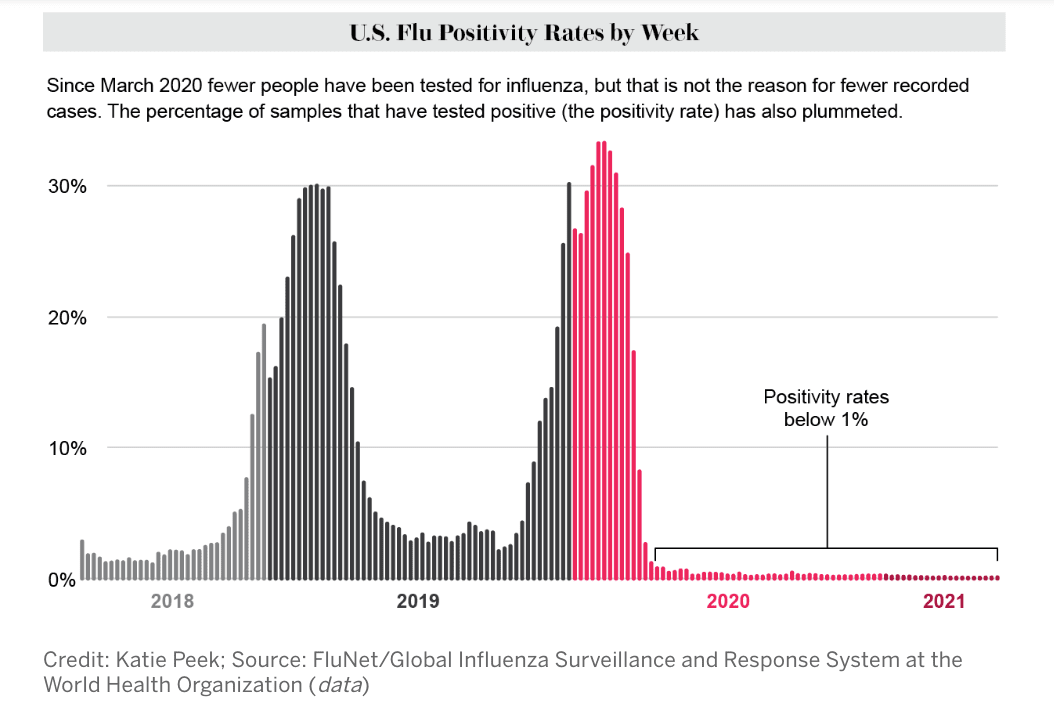How Influenza Cases Were Recategorized as Covid Cases
Executive Summary
- Influenza has nearly disappeared since the arrival of covid.
- Establishment health experts cannot address the idea of re-categorization of influenza cases as covid.

Introduction
The reporting of covid deaths has been irresponsible in that covid have been reported as the primary cause of death. In nearly all cases, influenza cases were most likely reported as covid cases.
Our References for This Article
If you want to see our references for this article and related Brightwork articles, visit this link.
Johns Hopkins Newspaper Removes Study Examining #COVID #Death Rate because real one is too lowhttps://t.co/FA8e1XrvUr #coronavirus
— Dr AngelovaShadowbannedCheckMyAccount (@angelovalidiya) January 20, 2021
#whoknew
"Top epidemiologist Knut Wittkowski says the massive drop in influenza cases is due to the fact that many are mistakenly counted as COVID-19 cases."
#askWHO #pandemic #whereisflu #COVIDー19 #flu https://t.co/GJ9QU8xGHf— Dr AngelovaShadowbannedCheckMyAccount (@angelovalidiya) January 15, 2021
Why Did Influenza Cases Drop Off a Cliff After the Pandemic?
The articles in the establishment media about the strange near elimination of influenza cases is humorous. One entity after another stepped forward to declare that the entirety of the influenza decline was due to social distancing and masks — even though as I cover in the article How There Was Never Any Evidence That Lockdowns Work to Combat Viruses, the scientific literature does not support social distancing or lockdowns to deal with viruses (influenza is a virus).
However, observe some of these quotes on the topic.
The Johns Hopkins epidemiologist already knew that flu transmission would be reduced because people were following the public health safety precautions recommended to prevent acquiring the novel coronavirus.
With people still wearing masks, washing their hands frequently and physically distancing, he expected these measures to temper the flu this year. And, with most public schools — major transmission routes for flu — likely remaining closed, in addition to restaurant and business closures, there were even fewer opportunities for flu to spread.
By Jan. 31, there had been only six cases of flu diagnosed this season at Johns Hopkins hospitals, including The Johns Hopkins Hospital, Johns Hopkins Bayview Medical Center, Howard County General Hospital, Sibley Memorial Hospital, Suburban Hospital and Johns Hopkins All Children’s Hospital. Those hospitals saw 4,805 cases in the 2019–20 season, and 2,846 in the 2018–19 season. Cases of other respiratory viruses besides influenza are down as well; the health system diagnosed only six positive cases of respiratory syncytial virus (RSV) by the end of January.
First, the virus that causes COVID-19 is very transmissible, given that it continues to spread — even with various public health measures in place. This also points to how easily respiratory viruses can spread through asymptomatic carriers, Klein says. – John’s Hopkins
This last claim about viruses being transmitted through asymptomatic carriers has been proven false. It is a pharmaceutical company talking point, as I cover in the article How Pharma and Media Lied About Asymptomatic Transmission to Promote Vaccines.
Secondly, did Johns Hopkins not consider that some influenza patients were reclassified as covid?
Observe the following graph.

Isn’t that odd. Influenza virtually went away after covid hit in early 2020. Covid precautions are really that effective in reducing influenza, or influenza was categorized as covid?
Here is JAMA or the Journal of the American Medical Association repeating the same hypothesis.
As in previous years, “it is likely that there were many more” flu deaths in the US, a CDC spokesman noted in an email. Not all flu deaths are reported to the CDC, and not all deaths due to flu-related complications are listed as such on death certificates.
Well that issue is certainly not the case with covid. Due to the CDC death certificate advisory, deaths have been massively over-allocated to covid.
The quote continues.
Except for a few places, such as western Africa, “the flu was essentially nowhere” this past fall and winter, virologist Richard Webby, PhD, of St Jude Children’s Research Hospital, 1 of 6 World Health Organization (WHO) Collaborating Centers for influenza, told JAMA in an interview.
And Scientific America.
As Scientific American reported in November 2020, the drop-off in flu numbers following COVID’s arrival was swift and global. Since then, cases have stayed remarkably low. “There’s just no flu circulating,” In comparison, the Centers for Disease Control and Prevention estimates there were approximately 22,000 U.S. deaths in the prior season and 34,000 deaths two seasons ago.
There is not a word in any of these establishment entities about the potential recategorization of influenza cases and deaths as covid cases and deaths.
Has the CDC Been Falsifying Influenza Deaths for Years
Before covid, the CDC was very much behind in pushing influenza vaccines, which the pharma companies that have taken control of the CDC financially benefit from. The CDC has also been instrumental in downplaying the risks associated with influenza vaccines. This is emphasized by the following quotations. This article in the Children’s Health Defense was published in October of 2018, before there was any hint of covid.
Every year at about this time, public health officials and their media megaphones start up the drumbeat to encourage everyone (including half-year-old infants, pregnant women and the invalid elderly) to get a flu shot. Never mind that more often than not the vaccines don’t work, and sometimes even increase the risk of getting sick.
Viewed within the context of Doshi’s remarks, the CDC’s high-flying flu numbers for 2017-2018 raise a number of questions. If accurate, 80,000 deaths would represent an enormous (and mystifying) one-year jump—tens of thousands more flu deaths compared to the already inflated numbers presented for 2016 (and every prior year).
The CDC’s statistics are impervious to independent verification because they remain, thus far, unpublished—despite the agency’s pledge on its website to base its public health pronouncements on high-quality data derived openly and objectively.
How did the CDC reach its as-yet-unpublished conclusion—widely shared with the media—that 79,820 American adults in addition to 180 children died from the flu in 2017-2018? The agency states that it relies on death certificate data. However, members of the Cochrane research community have observed that “when actual death certificates are tallied, influenza deaths on average are little more than 1,000 yearly.”
This goes back to a primary issue with the CDC — which is that they release unreliable statistics that are backward-engineered to drive demand for pharmaceutical products. The following quote brings up the topic of the politicization of US death statistics.
Other knowledgeable individuals have also noted that the death records system in the U.S. is subjective, incomplete and politicized, and have suggested that citizens should adopt a “healthy skepticism about even the most accepted, mainstream, nationally reported CDC or other ‘scientific’ statistics.” This skepticism may be especially warranted for the influenza stats, which are so inextricably intertwined with the CDC’s vaccination agenda that the statistical techniques and assumptions that the agency uses focus specifically on “project[ing] the burden of influenza that would have occurred in the absence of vaccination.”
This is curious because most people simply accept CDC statistics as unbiased and correct.
It takes little subtlety to recognize that the principal reason for flu hyperbole is to sell more vaccines. However, more and more people—even infectious disease specialists—are realizing that flu shots are fraught with problems. Roughly four-fifths of the vaccine injury and death cases settled through the National Vaccine Injury Compensation Program are flu-vaccine-related.
This quote makes it clear that the CDC has a pattern of adjusting statistics to sell vaccines.
A systematic review of influenza vaccine trials by Cochrane in 2010 urges the utmost caution. Noting that “studies funded from public sources [have been] significantly less likely [than industry-funded studies] to report conclusions favorable to the vaccines,” and citing evidence of “widespread manipulation of conclusions,” the Cochrane reviewers’ bottom line is that “reliable evidence on influenza vaccines is thin.”
Using spokespeople like Paul Offit and Peter Hotez as well as its extensive media partnerships and captive bureaucrats at CDC, the pharmaceutical industry has effectively banished the scientific debate about flu shot safety and efficacy from the public square.